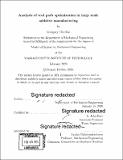| dc.contributor.advisor | A. John Hart. | en_US |
| dc.contributor.author | Dreifus, Gregory. | en_US |
| dc.contributor.other | Massachusetts Institute of Technology. Department of Mechanical Engineering. | en_US |
| dc.date.accessioned | 2020-10-18T21:49:38Z | |
| dc.date.available | 2020-10-18T21:49:38Z | |
| dc.date.copyright | 2020 | en_US |
| dc.date.issued | 2020 | en_US |
| dc.identifier.uri | https://hdl.handle.net/1721.1/128084 | |
| dc.description | Thesis: S.M., Massachusetts Institute of Technology, Department of Mechanical Engineering, 2020 | en_US |
| dc.description | Cataloged from PDF of thesis. | en_US |
| dc.description | Includes bibliographical references (pages 95-99). | en_US |
| dc.description.abstract | In large scale extrusion additive manufacturing, otherwise known as Big Area Additive Manufacturing (BAAM), systems, a heated extrusion will deposit thermoplastic material above its glass transition temperature along a track in the trajectory of its tool path. Currently, the tool path trajectory of extrusion based 3D printers is determined by a slicer that largely accounts for the surface geometry of the underlying build to determine the motion of the print path. However, the tool path planning process in BAAM prints involves various parameters left that extruder motion could further optimize, including print time, structural integrity of the print, and heat transfer across the build. In this thesis, we outline various methodologies for tool path planning optimization in BAAM based on these principals. We describe a graph theoretical framework that allows us to deploy several graph theory algorithms, making use of the Chinese Postman and Traveling Salesman Problems to achieve desired results. We explain algorithms that can solve the Chinese Postman Problem in order to print mesh cores with gradated core sizes for faster printing of structures with tailored mechanical properties. We then explain the implementation of two alterations of the Miller-Tucker-Zemlin (MTZ) algorithm to find Hamiltonian paths for the production of 3D printed infill patterns. Lastly, we analyze how our MTZ approach can help improve the thermal properties of our prints. We do a scaling analysis of our tool paths and summarize the concept of isothermal normalized weld time, which we study using simulations of our prints to understand how our MTZ algorithm has influenced the thermal histories of our builds and, therefore, the quality of our 3D prints. | en_US |
| dc.description.statementofresponsibility | by Gregory Dreifus. | en_US |
| dc.format.extent | 99 pages | en_US |
| dc.language.iso | eng | en_US |
| dc.publisher | Massachusetts Institute of Technology | en_US |
| dc.rights | MIT theses may be protected by copyright. Please reuse MIT thesis content according to the MIT Libraries Permissions Policy, which is available through the URL provided. | en_US |
| dc.rights.uri | http://dspace.mit.edu/handle/1721.1/7582 | en_US |
| dc.subject | Mechanical Engineering. | en_US |
| dc.title | Analysis of tool path optimization in large scale additive manufacturing | en_US |
| dc.type | Thesis | en_US |
| dc.description.degree | S.M. | en_US |
| dc.contributor.department | Massachusetts Institute of Technology. Department of Mechanical Engineering | en_US |
| dc.identifier.oclc | 1199330953 | en_US |
| dc.description.collection | S.M. Massachusetts Institute of Technology, Department of Mechanical Engineering | en_US |
| dspace.imported | 2020-10-18T21:49:35Z | en_US |
| mit.thesis.degree | Master | en_US |
| mit.thesis.department | MechE | en_US |
